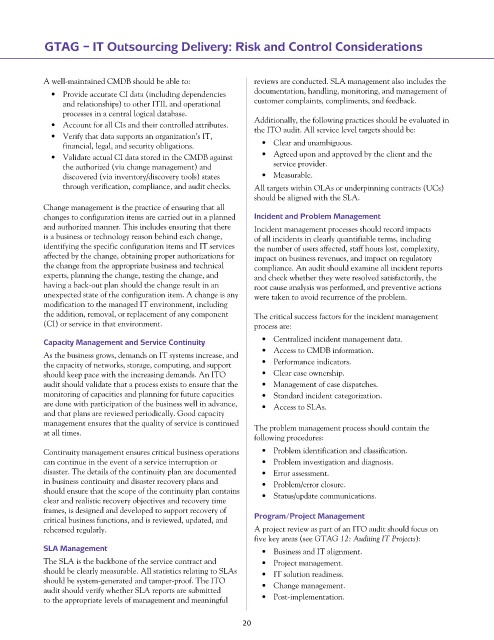Page 532 - ITGC_Audit Guides
P. 532
GTAG – IT Outsourcing Delivery: Risk and Control Considerations
A well-maintained CMDB should be able to: reviews are conducted. SLA management also includes the
• Provide accurate CI data (including dependencies documentation, handling, monitoring, and management of
and relationships) to other ITIL and operational customer complaints, compliments, and feedback.
processes in a central logical database.
• Account for all CIs and their controlled attributes. Additionally, the following practices should be evaluated in
the ITO audit. All service level targets should be:
• Verify that data supports an organization’s IT,
financial, legal, and security obligations. • Clear and unambiguous.
• Validate actual CI data stored in the CMDB against • Agreed upon and approved by the client and the
the authorized (via change management) and service provider.
discovered (via inventory/discovery tools) states • Measurable.
through verification, compliance, and audit checks. All targets within OLAs or underpinning contracts (UCs)
should be aligned with the SLA.
Change management is the practice of ensuring that all
changes to configuration items are carried out in a planned Incident and Problem Management
and authorized manner. This includes ensuring that there Incident management processes should record impacts
is a business or technology reason behind each change, of all incidents in clearly quantifiable terms, including
identifying the specific configuration items and IT services the number of users affected, staff hours lost, complexity,
affected by the change, obtaining proper authorizations for impact on business revenues, and impact on regulatory
the change from the appropriate business and technical compliance. An audit should examine all incident reports
experts, planning the change, testing the change, and and check whether they were resolved satisfactorily, the
having a back-out plan should the change result in an root cause analysis was performed, and preventive actions
unexpected state of the configuration item. A change is any were taken to avoid recurrence of the problem.
modification to the managed IT environment, including
the addition, removal, or replacement of any component The critical success factors for the incident management
(CI) or service in that environment. process are:
Capacity Management and Service Continuity • Centralized incident management data.
As the business grows, demands on IT systems increase, and • Access to CMDB information.
the capacity of networks, storage, computing, and support • Performance indicators.
should keep pace with the increasing demands. An ITO • Clear case ownership.
audit should validate that a process exists to ensure that the • Management of case dispatches.
monitoring of capacities and planning for future capacities • Standard incident categorization.
are done with participation of the business well in advance, • Access to SLAs.
and that plans are reviewed periodically. Good capacity
management ensures that the quality of service is continued The problem management process should contain the
at all times.
following procedures:
Continuity management ensures critical business operations • Problem identification and classification.
can continue in the event of a service interruption or • Problem investigation and diagnosis.
disaster. The details of the continuity plan are documented • Error assessment.
in business continuity and disaster recovery plans and • Problem/error closure.
should ensure that the scope of the continuity plan contains • Status/update communications.
clear and realistic recovery objectives and recovery time
frames, is designed and developed to support recovery of
critical business functions, and is reviewed, updated, and Program/Project Management
rehearsed regularly. A project review as part of an ITO audit should focus on
five key areas (see GTAG 12: Auditing IT Projects):
SLA Management • Business and IT alignment.
The SLA is the backbone of the service contract and • Project management.
should be clearly measurable. All statistics relating to SLAs • IT solution readiness.
should be system-generated and tamper-proof. The ITO • Change management.
audit should verify whether SLA reports are submitted
to the appropriate levels of management and meaningful • Post-implementation.
20

